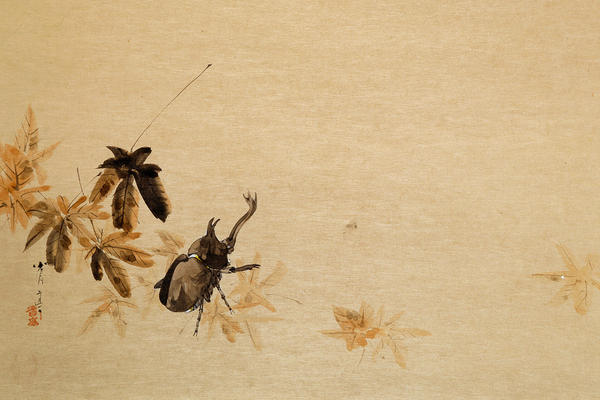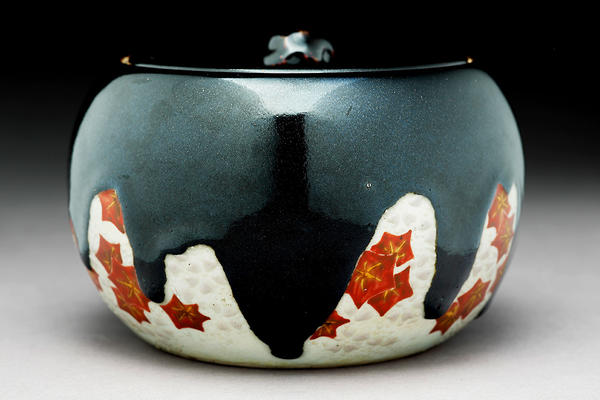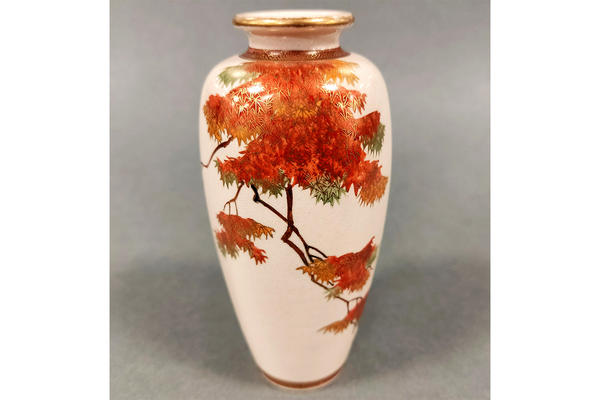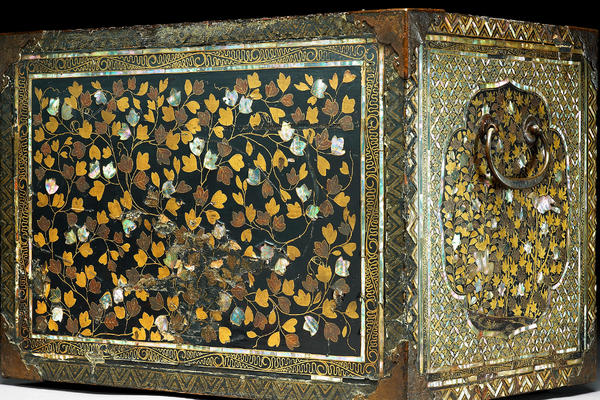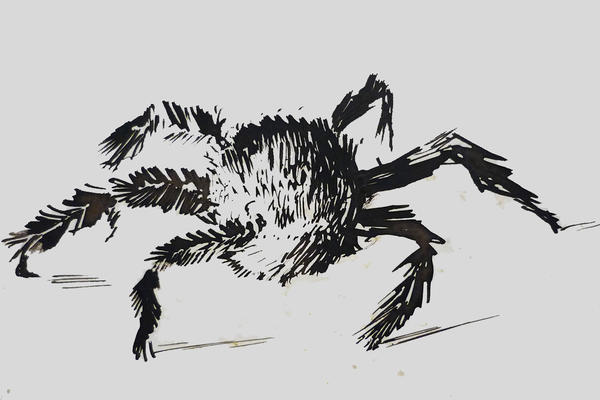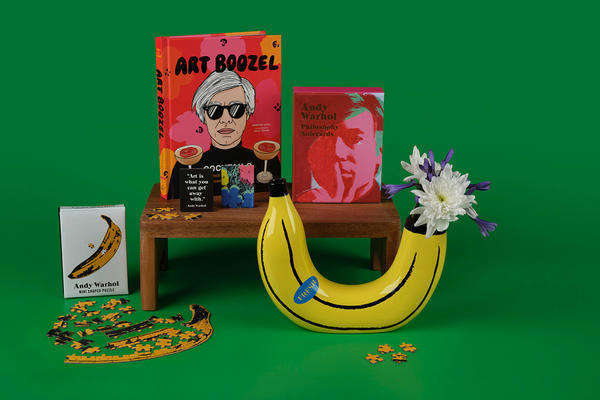AUTUMNAL SCENES
A collection of autumn-inspired artworks and objects from our collection
4-minute read
The leaves are falling and there's a parade of changing colours along the streets and in the parks of Oxford. Autumn is upon us.
We're celebrating the changing season by highlighting some of our favourite autumn-inspired scenes and objects from the collections.
INSPIRED BY AUTUMN
Beetle among autumn leaves
Venetian storage jar for quince pickle
Bookcase with autumn flowers
Japanese sword guard with maple leaf design
Autumn Fields, Condover
Lacquer box with maple leaves
The autumn fair at Dakor (detail)
Water jar decorated with maple leaves
Woodland creatures
Satsuma-style earthenware vase with autumn leaves
Japanese 'nanban' cabinet, with autumn leaves
Japanese ojime with autumn plants
Autumn
Autumn by Adriaen Collaert, after Maerten de Vos, 1587–88

In the foreground of this finely-executed engraving of an autumnal scene, a young naked Bacchus appears seated under a tree with a horn of plenty and vegetables. In the background a farmer herds his pigs, while people are busy working in a vineyard, crushing grapes and ploughing fields. Further back you'll see a village and mountains, with the zodiac symbols of Libra, Scorpio and Sagittarius up in the sky – an intriguing and allegorical story unfolds as you peruse the scene.
It's one of a set of Four Seasons prints by the prolific Flemish designer and engraver, Adriaen Collaert and part of the Ashmolean's extensive Francis Douce prints and drawings collection.
WA1863.7726
View by appointment in the Western Art Print Room
Autumn, Morning Mist, Éragny
by Camille Pissarro, 1902

Camille Pissarro (1830–1903) came to dislike the hard light of summer, in preference for the subtle tones of the other seasons, and this autumn landscape in oils demonstrates his perfect eye for those gentler tones and nuances.
He painted this same orchard many times, shifting perspective and scale to capture the change of season through composition as well as in the colour and light. This painting's title lists the many qualities Pissarro was able to capture – the season, the time of day, the weather conditions – and encourages comparison with his other paintings done at Éragny, revealing his mastery of atmosphere and tone.
WA1951.225.5
Not on display
Maple Trees at Mama, Tekona Shrine, and Linked Bridge
by Utagawa Hiroshige, 1857

The woodblock print is perhaps the most familiar form of Japanese art in the west and the masterful Utagawa Hiroshige (1797–1858) is among its greatest practitioners. This print is number 94 in his series One Hundred Famous Views of Edo, and depicts the view from Mama, ten miles outside of central Edo but a popular destination in autumn for its maple trees.
Hiroshige uses the branches and forked trunk of a maple tree as a dramatic framing device for the bridge and shrine beyond, drawing viewers into the scene. The palette of oranges, yellows, browns and greys enhances the autumnal mood, as does the line of geese viewed through the delicate brown leaves.
EAX.4362
Not on display
Autumn Chrysanthemum
by Xu Gu, 19th century
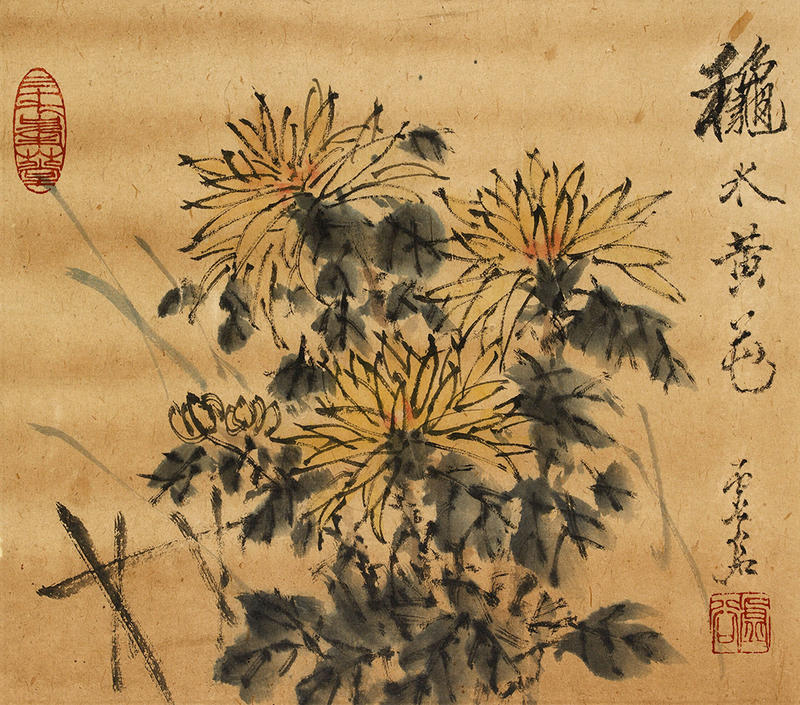
The chrysanthemum is a prominent autumn flower in Chinese gardens, and is regarded as one of the 'Four Gentlemen', symbolising unyielding spirit in adversity.
The theme of this painting may relate to a famous poem by Tao Yuanming, a reclusive poet from the mid-Six Dynasties period (c. AD 220–589). The poem describes Tao's life after quitting government service: 'I pluck chrysanthemums under the eastern hedge, then gaze long at the distant summer hills'. The chrysanthemum is often accompanied by hedges in Chinese paintings.
First an army official and then a monk, the artist Xu Gu (1823–1896) was associated with artistic circles in Yangzhou, and later with the Shanghai School in the 19th century. He is renowned for his depictions of flowers, fruits, birds, and fish using the side of a dry brush, a skill that is evident in this painting.
EA2000.154
Not on display
The Yellow Tree: Autumn Landscape
by Leonid Osipovich Pasternak, 1918

Leonid Osipovich Pasternak was father of the novelist and poet Boris Pasternak, author of 'Doctor Zhivago' (1957). Although Boris is perhaps better known today, Leonid was a much-admired Impressionist artist. Born in Odessa in 1862, he trained in Moscow and Munich before becoming well established in Moscow as a painter, illustrator and art teacher.
This vivid watercolour of a tree in all its autumn glory – most likely viewed from the window of his home – was painted in 1918, when he would have been living in Moscow with his wife Rosa and four children.
Leaving Russia for Berlin in 1921, Leonid then moved in 1938 to London, and eventually to Park Town in North Oxford. He lived here with his daughters Josephine and Lydia throughout the Second World War, while his sons Boris and Alexander remained in Russia. After his death in 1945, this work was among several generously presented to the Ashmolean to acknowledge the great enjoyment he derived as a regular visitor to the Museum.
Presumably the Park Town trees would have delighted Pasternak just as much as the Russian one in this watercolour, as they changed their colours in the autumn.
WA1958.19.3
Not on display, but you can view by appointment in the Western Art Print Room
Study of two gourds
by Jean-Baptiste Huet, 1785

A lovely watercolour illustration of two gourds by Jean-Baptiste Huet, the Neoclassical French painter who excelled at representing rural life from a botanist’s perspective, focussing on plants and flowers.
Huet was the son of a painter of animals and still life. He grew up in the Louvre, so from an early age knew artists such as François Boucher, whose decorative style influenced his work. However, Huet's actual teacher was the animal painter Charles Dagomer.
Huet made his own contribution to the artistic style of his time with pastorals and animal scenes, through watercolours and oil paintings. Many of his ideas for ornament designs were taken up and disseminated via various branches of craftsmanship – from tapestry weavers to cabinetmakers.
The Ashmolean has several fine illustrations by this artist in its collection.
WA1942.25
View by appointment in the Western Art Print Room
Flowers of Autumn
by Yamamoto Baiitsu, 1839

Yamamoto Baiitsu (1783–1856) was exceptionally skilled in the distinctive mokkotsu and tarashikomi techniques of painting.
Mokkotsu is known as the 'boneless' style, wherein ink or paint is applied with no outlines, or very few, and with washes of ink. Tarashikomi is a technique where a second layer of ink is applied while the first is still wet, creating an effect of pooled or 'puddled' colours. It was typically used for petals and leaves, like the large grey-brown leaves here.
Together, these techniques create clarity, serenity and sensuous textures, all very suitable for the tranquility and lyricism Yamamoto was seeking to bring to his image of autumn.
EA1966.116
Not on display
Allegories of Autumn and Winter
after Giuseppe Arcimboldo, 1590–1620

The Italian artist Giuseppe Arcimboldo (1526–1593) was well-known for his images of human heads created from a collection of unexpected objects, including fish, books, vegetables and flowers.
Using vegetables and fruits to depict seasonal changes is a simple stroke of genius, and the allegorical portrayals of autumn and winter here are inspired by some of Arcimboldo's works. They exploit our familiarity with the horticultural calendar to create an immediate sense of character.
Arcimboldo's allegorical depictions of the seasons were hugely popular with his Renaissance-era audience, and indulged their taste for puzzles, riddles and enigmas. Though many of his works were displaced during the Thirty Years' War (1618–1648) his reputation was revived by Surrealist artists in the early 20th century.
WA2003.Douce.4867
View by appointment in the Western Art Print Room



